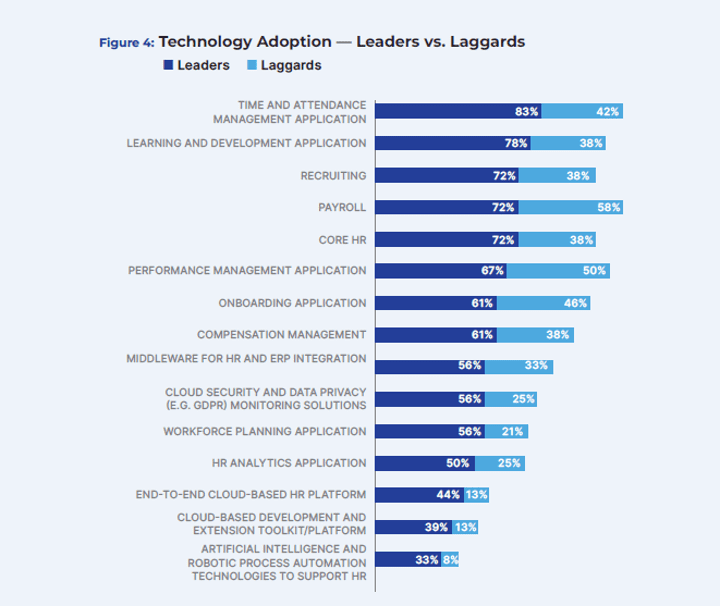You know the old joke about bear attacks, right? You don’t have to outrun the bear. You just need to outrun the hikers around you.
The same lesson applies to whether you are bearish or bullish on today’s labor market. It’s better to be a leader than a laggard.
Here’s how to tell if your organization is a HCM implementation leader or laggard:
Characteristics of HCM Implementation Leaders
Our comprehensive HCM and SAP S/4HANA – Benchmark Report, produced in partnership with WorkForce Software and SAP Insider, identified several areas where technology adoption leaders outpaced laggards:
- Time and attendance management (83% vs. 43%)
- Learning and development applications (78% vs. 38%)
- Recruitment tools (72% vs. 38%)
- Payroll solutions (72% vs. 58%)
- Core HR solutions (72% vs. 38%)
Leading organizations plan to use advanced HR technologies like HR analytics, intelligent automation, and cloud-based development platforms like SAP® BTP.
Characteristics of Laggards
A company may be late in implementing a Human Experience Platform HCM platform for several reasons, including:
Traditional HR Practices
An organization may still rely on traditional HR practices like rigid hierarchies, bureaucratic processes, and paper-based documentation. They may still view HR primarily as an administrative function instead of a strategic partner.
Siloed Systems and Data
HCM requires an integrated approach to workforce management, where planners aggregate data from various HR functions. Organizations falling behind may have disparate systems and data silos, making data-driven decision-making difficult.
Limited Employee Engagement
Some organizations struggle to engage and retain employees. Employee engagement may be low due to inadequate communication, lack of personalization, and a focus on compliance over employee well-being.
Resistance to Change
Resistance to change is a common reason organizations are reluctant to adopt new technologies to enhance the employee experience.
Outdated Technology
They may rely on outdated HR technologies or lack a modern HRIS (Human Resource Information System), making upgrading difficult.
Inadequate Training and Development
These organizations may not invest enough in employee training and development programs. Continuous learning and skill development are crucial components of HCM.
Poor Employee Feedback Mechanisms
They may lack effective mechanisms for collecting and acting on employee feedback. Regular feedback is essential for understanding and improving the employee experience.
Limited Focus on Diversity and Inclusion
Organizations behind in HCM implementation may not focus on diversity, equity, and inclusion (DEI) initiatives, which are integral to creating an inclusive and supportive work environment.
Limited Remote Work Flexibility
The COVID-19 pandemic highlighted the importance of remote work and flexibility. Organizations falling behind in HCM adoption may struggle to provide tools and support for remote employees.
Lack of Data-Driven Insights
They may not use data analytics to understand workforce trends and performance. HCM relies on data to make informed decisions, and lagging organizations may miss valuable insights.
Failure to Prioritize Well-being
These organizations may not prioritize employee well-being, including mental and physical health. Well-being initiatives contribute to overall job satisfaction and productivity.
Inefficient Recruitment and Onboarding
The recruitment and onboarding processes may be slow and cumbersome. In HCM, organizations aim to provide a seamless and engaging experience when candidates apply for positions.
Leaders Choose the Cloud for HCM
SAPinsider’s findings reveal a clear divide in HCM strategy performance between companies embracing cloud-based HCM systems and those organizations clinging to on-premises HR solutions:
- Leading organizations are 50% more likely to run SAP HCM SuccessFactors in the cloud
- Lagging organizations are nearly 2.5 times more likely to run HR systems on-premises
Leaders and Laggards Agree
All organizations want to improve HR strategies, create an engaging work environment, and make the business more successful.
Companies must transition from purely administrative HR processes to a more integrated, employee-centric approach to achieve this. This is where HCM systems and modern ERP platform adoption become essential.
Create a Roadmap to HCM Implementation
Regardless of where your company is with HR technology adoption, you need a roadmap that connects with business objectives and employees’ needs.
A move toward an interconnected and employee-centric model based on a Human Capital Management (HCM) system will define your future in HR management.
Download the Complete Report
Ready to dig into more HCM details?
Download our HCM and SAP S/4HANA – Benchmark Report, written in partnership with WorkForce Software and SAP Insider.
Rizing Gets HCM
We understand the evolving needs of HR leaders like you and offer tailored HCM solutions to maximize productivity, enhance employee satisfaction, and lower employee turnover. We’d love to chat about how our solutions can empower your organization.



